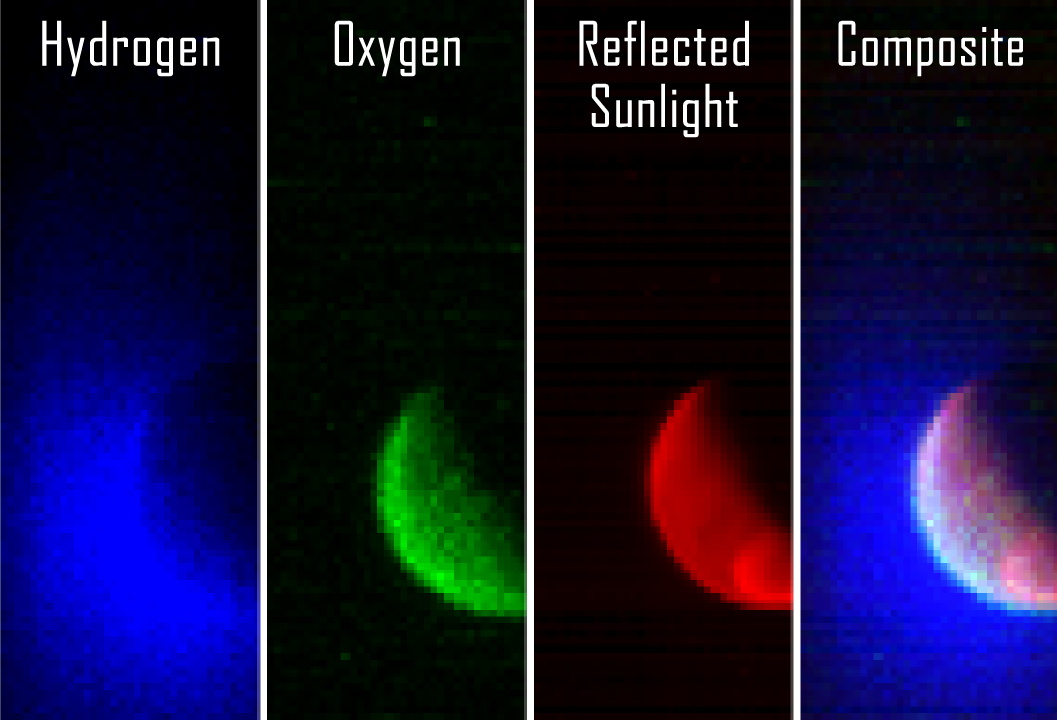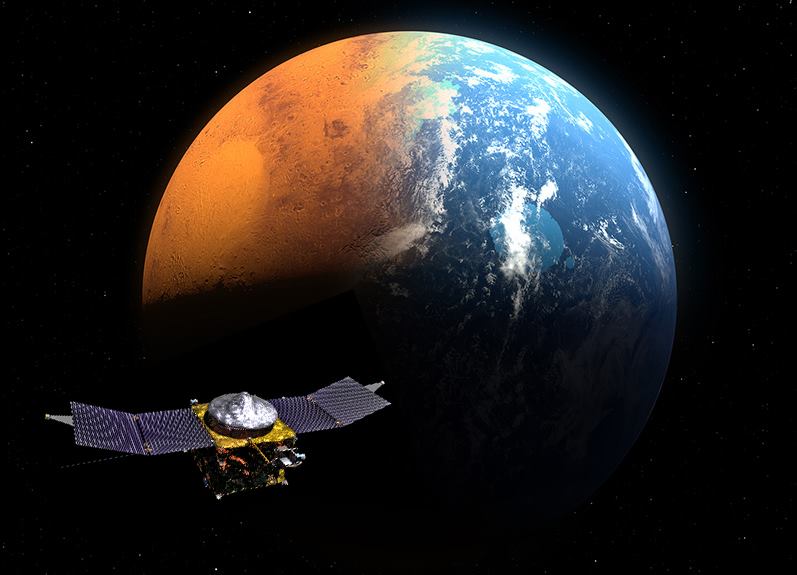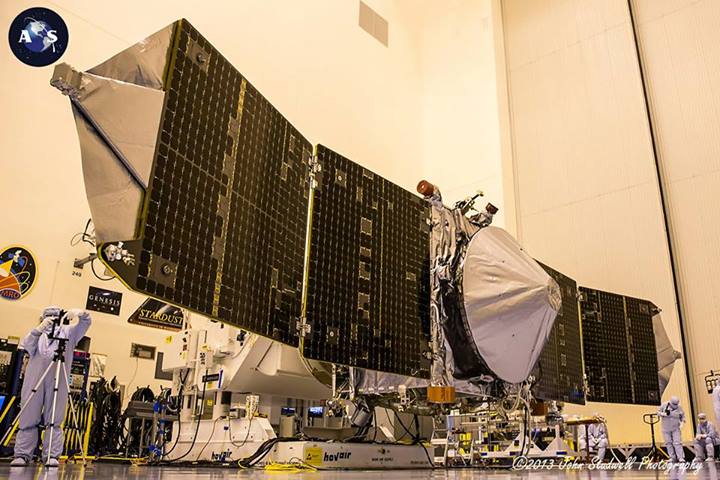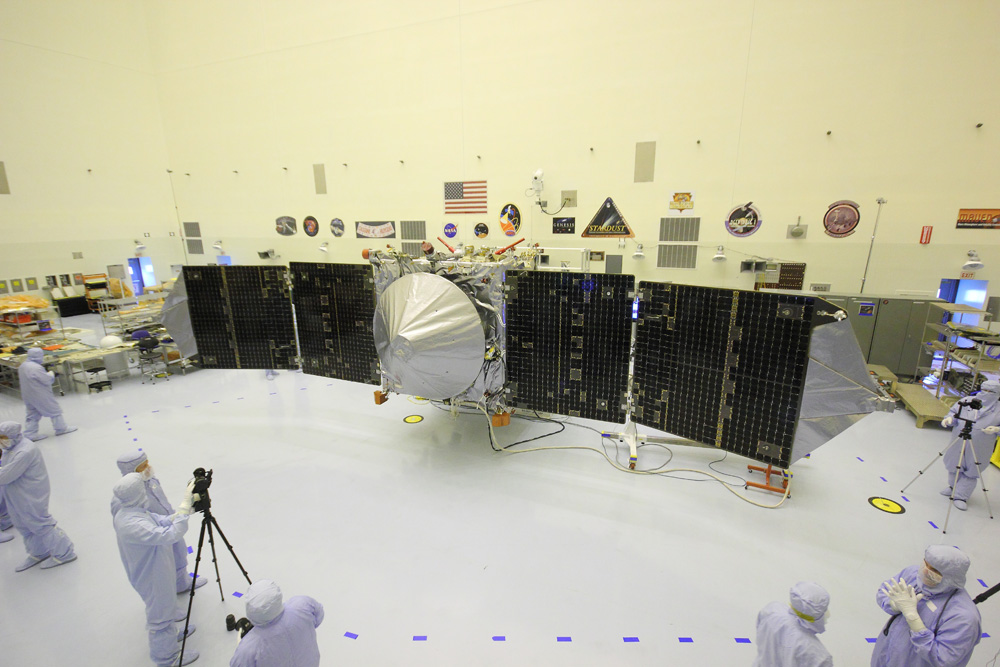
Just eight hours after the nail-biting arrival of NASA’s MAVEN orbiter at Mars on Sept. 21, the probe has already captured totally unique “real science” that will “never” be possible again, said Prof. Bruce Jakosky, MAVEN principal investigator with the Laboratory for Atmospheric and Space Physics at the University of Colorado, Boulder, in an exclusive interview with AmericaSpace.
Why the rush for science?
Because after arriving at Mars, MAVEN was placed into a highly elliptical but temporary “capture orbit” after successfully completing the crucial Mars Orbit Insertion (MOI) maneuver at 10:24 p.m. EDT Sunday, Sept. 21, following the 10-month interplanetary journey from Earth.
“We wanted to get several of the instruments turned on as quickly as possible, so that we could collect observations in our 35-hour capture orbit,” Jakosky stated.
The Mars Atmosphere and Volatile Evolution (MAVEN) spacecraft’s Imaging Ultraviolet Spectrograph (IUVS) instrument obtained the first series of false-color images of Mars, shown above, on Sept. 22, from an altitude of 36,500 kilometers in three ultraviolet wavelength bands—for hydrogen, oxygen, and reflected sunlight.
The elliptical capture orbit enables a brief window of one-time-only high altitude science observations, because it won’t last long.
And the whole point was to collect really useful data and not just test the instrument. Because by week’s end, MAVEN’s apoapsis will be reduced by thruster firings.
“These images are not intended just to show that the instruments work, but are real science data; we’ll be analyzing it to determine the gas abundances up to very high altitudes,” Jakosky elaborated.
“On Friday [Sept. 26], we’ll lower the apoapsis. So we’ll never be this high again.”

What science is being accomplished?
“Observing with the IUVS now lets us measure the distribution of hydrogen to much higher altitudes, and addresses specific questions about its distribution and the energetics of forming the extended corona,” Jakosky explained.
Since hydrogen is the lightest gas, it’s the hardest for gravity to hold on to and the easiest to escape. By contrast, heavier oxygen is bound to Mars more tightly by gravity.
What do the different spectra represent?
“Blue shows the ultraviolet light from the sun scattered from atomic hydrogen gas in an extended cloud that goes to thousands of kilometers above the planet’s surface. Green shows a different wavelength of ultraviolet light that is primarily sunlight reflected off of atomic oxygen, showing the smaller oxygen cloud. Red shows ultraviolet sunlight reflected from the planet’s surface; the bright spot in the lower right is light reflected either from polar ice or clouds,” according to a NASA statement.
Hydrogen and oxygen form from the breakdown of water and carbon dioxide in Mars’ atmosphere. MAVEN’s science goal is to determine the rate of loss of hydrogen and oxygen from Mars’ atmosphere over time.
How will the instrument resolution change as MAVEN is lowered to its final mapping orbit with an apoapsis of some 6000 kilometers?
“Once we’re in our mapping orbit, we’ll get higher spatial resolution, but mainly because we’ll be lower down. The resolution of this instrument was chosen to match with the spatial resolution we need to understand upper-atmosphere properties,” Jakosky said.

After achieving orbit, Jakosky also emphasized that MAVEN begins a six week “commissioning phase.” But despite that important engineering task, MAVEN is already collecting highly useful science data, pleasing the science team that worked on this project for 11 years to no end.
And upcoming in October, MAVEN will take another time-out for science to capture several days worth of extremely valuable once-in-a-lifetime research observations during the extremely close approach of Comet Siding Spring. (Details on those comet observations in an upcoming story.)
The $671 million MAVEN spacecraft’s goal is to study Mars’ upper atmosphere to explore how the planet may have lost its atmosphere and water over billions of years.
Scientists will use these loss rate observations to correlate with when the Red Planet underwent dramatic climate and transitioned from its ancient, water-covered past to the cold, dry, dusty world it has become today.
Scientists from MAVEN, MOM, Curiosity, Opportunity, and all the orbiters will work in concert utilizing all the data to elucidate the history of Mars potential for supporting life—past and present.

MAVEN is the first spacecraft dedicated to exploring the tenuous upper atmosphere of Mars.
Stay tuned here for continuing developments regarding Earth’s “Missions to Mars.”
Want to keep up-to-date with all things space? Be sure to “Like” AmericaSpace on Facebook and follow us on Twitter: @AmericaSpace
Missions » MAVEN » Missions » MOM »


